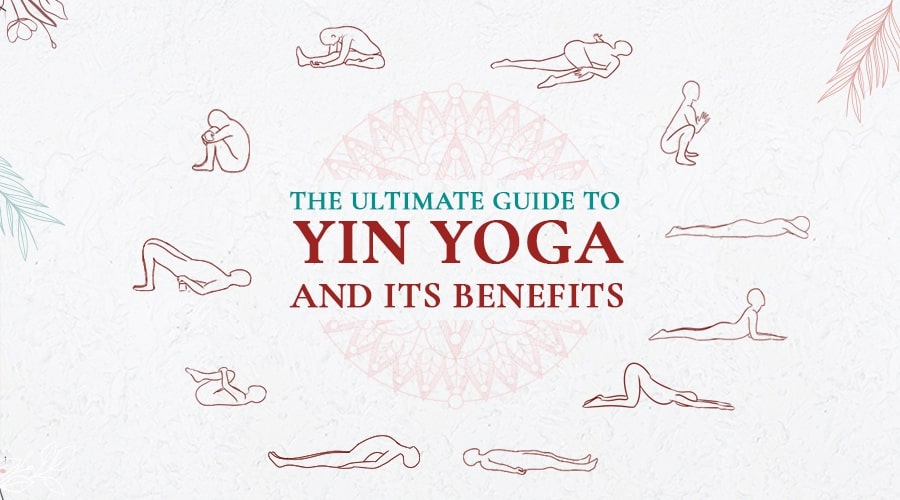In 2002, a curious student asked if I taught Yin Yoga. Admittedly, I had to ask, "What is Yin Yoga?" She explained that it was a 'lazy' style of yoga from China, perfect for relaxation without much movement involved. I laughed, thinking I'd never teach such a style. But as time passed and more students mentioned it, my curiosity grew.
Determined to understand the true meaning of Yin Yoga, I took a course with author and Yin Yoga Master, Biff Mithoefer. There, I experienced something very different to the “lazy” style I had been told about. Classes explored gentle, passive stretches, with a focus on connective tissues and energies. I began to delve deeper into Yin Yoga, training with the founder of this unique style, Paul Grilley, over two years. During this time, I gained a significant understanding of Yin Yoga and the benefits it can offer when practiced correctly.
If you're new to this practice or simply want to learn more, this complete guide will breakdown the core principles of Yin Yoga, its transformative benefits, and 5 Yin archetypes that'll elevate your practice. So, if you've ever wondered what Yin Yoga is beyond relaxing asanas, keep reading.
What Is Yin Yoga?
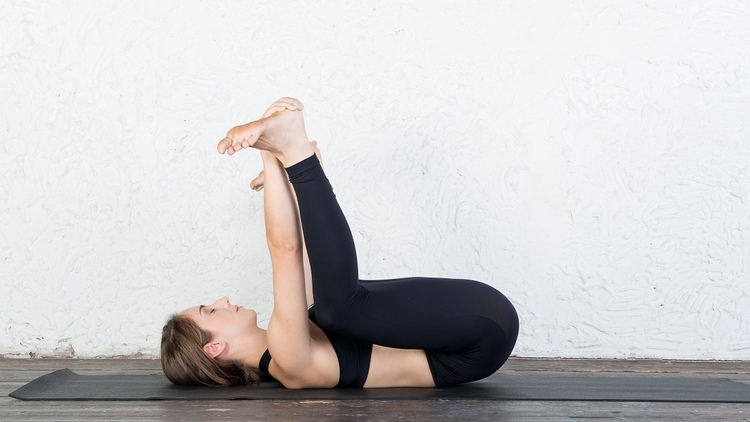
Yin Yoga is a new style of yoga, where practitioners immerse themselves in passive poses for extended periods, typically ranging from 3-10 minutes.
It’s widely believed that Yin Yoga originated in China, but the practice is in fact deeply rooted in the time-honored tradition of Classical Hatha Yoga. Initially, Hatha Yoga, with its long holds, was a monk's discipline, where poses would be held for up to 10 minutes at a time. However, as gurus like Swami Sivananda introduced it to the masses, durations were adjusted to 1-3 minutes to make it more accessible.
Yin Yoga can easily be distinguished by its focus on passive (yin) postures which minimize muscle activity and stretch the connective tissues. It's about effortlessly settling into a pose, often supported by props such as cushions and bolsters. While the postures are reminiscent of Classical Hatha Yoga asanas, they've been renamed to stand apart. Paul Grilley describes Yin Yoga quite perfectly in his book as “old wine in a new bottle.” Keep reading to find out the key differences between Yin and Hatha Yoga.
Origin & History of Yin Yoga
Yin Yoga began in the late 1980s. Founder Paul Grilley came across a presentation on TV of Paulie Zink—a martial arts champion and Taoist Yoga master—and was amazed at Zink's flexibility. Eager to learn, Grilley attended Zink's Taoist Yoga classes, experimenting with long holds of 5-10 minutes. However, after months of training, Grilley didn't see the results he'd hoped for, and he returned home to continue practicing dynamic styles like Vinyasa Yoga.
Over time, he began to teach some passive stretching classes to his students. The results were overwhelming; he saw rapid improvement in the range of motion of his students. Inspired by Buddhism, he called his classes Yin Yang Yoga. Grilley’s student, Sarah Powers, suggested a better name would be Yin Yoga given the focus on passive postures. And thus, Yin Yoga was born.
Key Characteristics of Yin Yoga
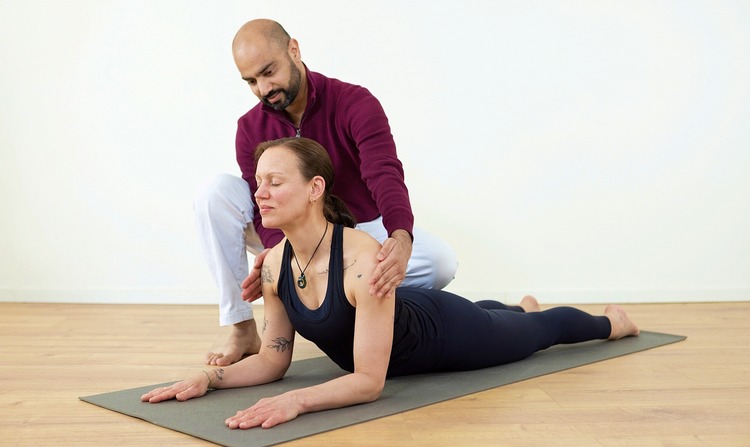
Long-Held Yoga Poses
In Yin Yoga, poses are typically held for a generous 5 to 10 minutes. This stands in contrast to the dynamic practices of Ashtanga Vinyasa and Vinyasa Flow, where poses last 5 to 10 breaths.
While Hatha Yoga is more static by nature, beginners usually maintain a pose for no more than 3 minutes—still shorter than in Yin Yoga. (Side note: Historically, asanas often had 5 to 10-minute holds too!)
When we hold a pose for a longer period, we bring the stretch to the yin tissues, which are the deeper tissues such as the tendons, fascia, ligaments, and the other connective body tissues. Our yin tissues are less vascular (supplied with blood) and elastic, and therefore need more time to stretch. When stretched regularly, it increases the overall flexibility, circulation, and range of motion in the joints and ligaments.
On the other hand, dynamic styles like Vinyasa emphasize muscle movement and stretching. Muscles, being yang tissues, warm and stretch quickly but cool and retract just as fast. That’s why if you miss a few days of practice, you might notice a decrease in both flexibility and strength.
So, if you practice only dynamic forms of exercise or yoga, you will gain muscle strength, but not necessarily a wider range of motion. To have a healthy range of motion around our joints, many of us need to also stretch the deep connective tissue and the joints. According to Paul, Yin Yoga is a complementary practice, not a substitute for the more Yang exercises.
Try these 8 Seated Yoga Poses for Flexibility
Breathing Patterns
Conscious, controlled breathing is a central aspect of yoga. The way we regulate our breathing affects how our muscles and minds respond to a particular pose. We often practice calming breathing exercises before and during our practice to find focus and stillness, amongst many other benefits.
- In Yin Yoga, the emphasis is on relaxed belly breathing. Long, slow, and deep breaths promote total relaxation, helping you hold a pose for longer durations and access new depths.
Understanding the Meaning of Yin & Yang in Yoga
The concept of yin and yang is similar to that of the Ida (moon) and Pingala (sun) from the Hatha Yoga tradition. Yin Yang is mentioned in Traditional Chinese Medicine, and Ida Pingala is mentioned in yoga and Ayurveda.
These are ancient principles that describe the two opposite forces in nature present in everything. The principle of yin and yang, while contrary to each other, is not rigid but relative. The unique qualities of yin and yang are:
- Yin: Slow, soft, passive, and cold. It is also associated with water, earth, moon, femininity, heavy, and night.
- Yang: Fast, hard, active, hot, masculine, light, and day.
In yoga, we see this difference in the practice of asanas. Some poses are passive and activate yin tissues and qualities, whereas other poses are more dynamic, activating yang tissues.
Differences Between Yin & Yang Tissues
How do you identify yin and yang tissues in your body? We can break it down by analyzing the movement of the body and which parts we are activating in any given pose.
Yin Tissues | Yang Tissues |
|---|---|
Resist stretching & rebound slowly like dough | Stretch easily & rebound quicker like rubber |
While yang and yin tissues are distinctly different, all tissues are a blend of yin and yang qualities. For example, the tendon of a muscle can be dense like a ligament (yin), but the muscle can be quite elastic (yang).
Furthermore, Paul Grilley maintains that all tissues can be worked in a yin or a yang way. Yang, for instance, is rhythmic and repetitive like weightlifting or running in which targeted muscles are generally contracted, while yin is slow with static-like traction where the targeted muscles are relaxed. If you train fascia in a yin way, it becomes longer and more elastic while yang makes it shorter, stronger, and stiffer.
5 Functional Principles of Yin Yoga
At the core of Yin Yoga are three primary stresses: tension, contraction, and compression. Flexibility refers to the extensibility (capacity to stretch) of the myofascial groups, ligaments, joint capsules, and discs. Compression is the ultimate range of motion in every person. However, range of motion varies from person to person, and the maximum in a pose looks and feels different depending on your anatomy. To avoid injury and reap the many benefits of Yin Yoga, it’s essential that you keep these principles in mind when practicing and teaching:
1. Apply Stress Gently
The true essence of yoga is to balance the flow of prana (or life energy) within us. In Yin Yoga, this balance is achieved by strategically stressing our body's deep connective tissues. When these tissues are gently stressed, energy flows more freely, promoting balance within and overall well-being.
2. Make Mindful Movements
When practicing Yin Yoga, remember there's no "one-size-fits-all" or perfect pose. Every adjustment—be it in the hand, foot, or spine—either aids or hampers our ability to target specific areas. Because everyone's anatomy varies, it's vital to listen to your body and find the position that works best for you.
3. Stick to a Safe Discomfort Level
Everyone's skeletal system is unique. This means what feels comfortable or achievable for one person might be challenging or even unattainable for another. It's essential to approach Yin Yoga with an understanding and acceptance of these differences, focusing on what feels right for your own body.
I always encourage my students to aim for the orange zone of discomfort. In this zone, you feel discomfort but can stay in the pose for the full duration. This allows for optimal level stress and stretch, targeting the connective tissues and providing the maximum benefit.
4. Find Stillness
Once you reach a tolerable level of intensity, be still. This is one of the most challenging parts of Yin Yoga, as you’ll need to muster the mental strength to fight off fidgeting and the natural urge to exit a pose. However, maintaining stillness for up to 5 minutes in each pose is necessary to effectively stretch the tissues. If you feel your mind begin to wonder or muscles itch, try to bring your awareness inwards. Props are also encouraged to ease tension and provide support in certain areas.
5. Exit Slowly
After sinking into the stillness of a Yin Yoga pose, the body's deeper tissues, muscles, and joints may have been under sustained stress or placed in strange positions. Therefore, when releasing from a Yin Yoga pose, particularly one held for an extended duration, it's essential to move gently and deliberately. A hasty exit can be dangerous for the body, potentially leading to injury. Think of this slow release as giving your body the time it needs to adapt and recalibrate.
What Are the Benefits of Yin Yoga?
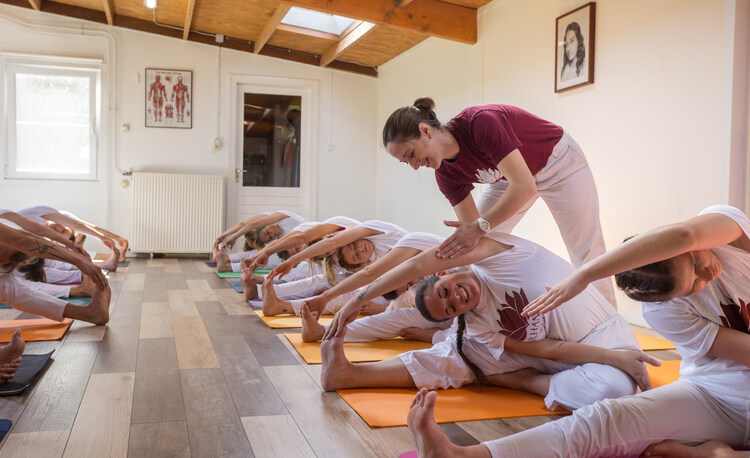
In today's fast-paced world, many practitioners are turning to Yin Yoga for holistic health and well-being. Distinct from its more dynamic counterparts, Yin Yoga’s passive poses offer self-awareness and relaxation while the extended holds allow practitioners to access and stretch deeper layers of the body. Here’s how Yin Yoga benefits the mind and body.
Physical Benefits
Fascia Rejuvenation
Regular Yin Yoga practice stimulates and stretches the body's fascia; the thin sheath of connective tissue that surrounds every part of your body. Consistent stretching makes the fascia more adaptable, improving the distribution of nutrients and overall functioning of the body.
Ligament & Joint Health
Over time, our ligaments naturally tend to contract. Yin Yoga introduces a gentle but effective stretch to these ligaments, preserving and even enhancing our joints' range of motion.
Yin Yoga also curbs the negative effects of a desk-bound or sedentary lifestyle by applying calculated pressure to the joints, revitalizing and renewing their essential fluids. In other words, we stay younger by stretching our ligaments.
Improves Flexibility
While high-intensity activities might strengthen tendons, they can also lead to rigidity. Yin Yoga offers a counterbalance, gently stretching tendons and promoting their flexibility. As the tendons connect our muscles to our bones, lengthening them makes your muscles more responsive and adaptable to various movements, helping reduce injuries.
Read: The Ultimate Guide to Yoga for Strength and Flexibility
Migraine Relief
Yoga activates the parasympathetic nervous system, which is responsible for our rest and digest response. Studies show that this naturally calming effect on the mind can help people overcome anxiety and depression, thereby reducing the episodes of migraine. Along with deep breathing exercises, practicing certain Yin Yoga poses for migraines can provide relief and reduce the symptoms of an attack.
Mental & Emotional Benefits
Mental Clarity
The practice of Yin Yoga emphasizes stillness — of the mind, body, and spirit. Such moments of intense pause and reflection often lead to enhanced mental clarity, allowing you to release deep-rooted tension and pave the way to a healthier mindset.
Stress Reduction
Deep, prolonged stretches in Yin Yoga can release stress stored in tissues. Emotional releases, although sometimes intense, are a natural part of this process, and are especially common in wide hip opening poses like Pigeon Pose. Promoting this natural release through Yin, whether physical or emotional, is an excellent way to let go of stress and tension that could be holding you back in life.
See: 7 Powerful Yoga Practices for Burnout, Anxiety & Stress Relief
Hormonal Balance
Extended poses like those practiced in Yin Yoga sequences stimulate the endocrine glands. This leads to better hormonal regulation and more balanced emotional states.
Reduces Anxiety & Depression
Recent studies have highlighted Yin Yoga's effectiveness in reducing plasma adrenomedullin levels, a biomarker associated with stress, anxiety, and depression. Incorporating Yin Yoga into your daily routine can limit the negative health effects associated with high stress while also providing people with the tools to better manage these challenges.
Yin Yoga Poses - The 5 Archetypes Explained
If you have practiced or taught Yin Yoga, then you’ll know there are many different poses. In our Yin Yoga teacher training course, we teach more than 60 poses alone. However, almost all of these asanas are variations of five key archetypes—Shoelace, Saddle, Caterpillar, Dragonfly, and Twist—with each targeting specific muscular and skeletal areas in the body. Therefore, having a basic understanding of these Yin archetypes will help you come into each pose safely, while also increasing (or decreasing) the intensity to suit your needs.
According to Paul Grilley, the five archetypal poses in Yin Yoga are:
1. Shoelace
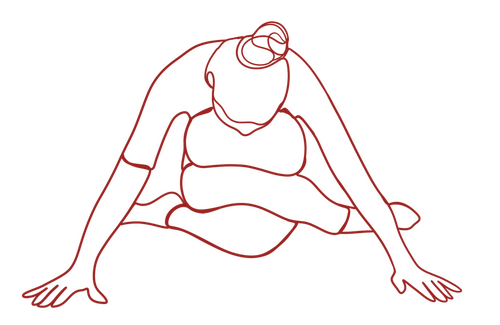
Variations:
- Tight
- Loose
- Untied
- Broken
Target Areas:
- Glutes
- Adductors
- Thoracolumbar fascia
Benefits:
- Stretches the dip lateral rotators
- Stimulates knee joints and stretches spinal ligaments
Contraindications:
- People with stiff hips or sensitive knees will need modifications in this pose to avoid straining their knees.
- Pregnant women should keep their backs straight.
How to Practice:
- Begin by sitting on your heels.
- Slide onto one buttock and bring the outside foot over toward the opposite hip.
- Once the legs are in position, and if comfortable, bend forward.
Modifications:
- If this is too uncomfortable, you can sit cross-legged or in half lotus position and then bend forward.
- People with lower back issues can keep the back straight.
- People with tight hips or knees can sit on a folded blanket or block.
- If the pressure is too intense in the hips or knees, remain upright or take more weight into the hands and arms.
- To ease the flexion, you can place a bolster under the chest.
- When folding forward, you can support the head with the hands, leaning the elbows onto the thighs or a block or bolster.
- You can keep your hands on your side, or in front of you, or extend the arms backward.
Counter Poses:
- Corpse Pose
- Angel Pose
- Child’s Pose
Recommended Hold Time for beginners:
- 3 – 5 minutes each side
Read more: How to Practice Swan Pose for all Levels of Mobility
2. Saddle
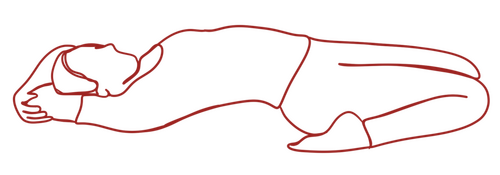
Target Areas:
- Quads
- Hip flexors
- Rectus abdominis
- Obliques
- Thoracolumbar fascia
Benefits:
- A deep opening in the sacral-lumbar arch
- Stretches hips flexors and quadriceps
- Stimulates the thyroid gland
Contraindications:
- This Yin Yoga Pose can be uncomfortable for people with tight back or tight sacroiliac (SI) joints.
- People with tight quads or knee problems will need to modify the pose to avoid injury.
How to Practice:
- Start with sitting on the knees, in Diamond Pose.
- Bring the heels out, next to your buttocks. Lean back on your hands and then on your elbows.
- Slowly move further to place your head on the ground and hold your elbows above your head.
- To come out, shift your weight on your elbows and then straighten your legs one by one.
Modifications:
- You can place a bolster under the lower back or under the shoulders to release pressure on back and legs.
- You can place a blanket under the ankles if required.
- Beginners can straighten one leg for Half Saddle if they have difficulty.
- Sit on a block and lean back on your hands (do not try to lie all the way down).
Counter Poses:
- Air Release Pose
- Angle Pose
- Corpse Pose
Recommended Hold Time for Beginners:
- 3 – 5 minutes
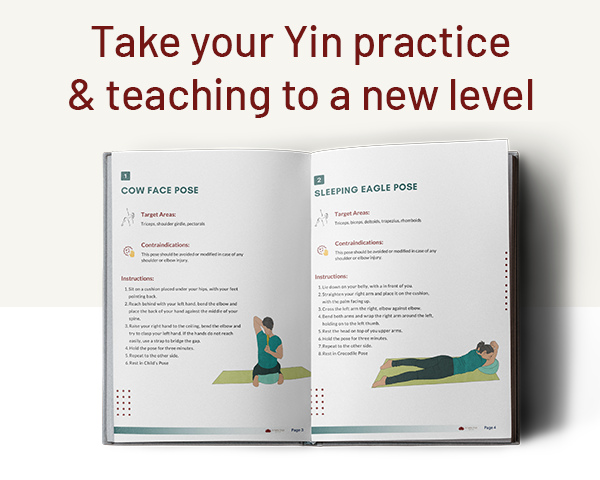
Get the illustrated e-book 10 Yin Yoga Poses for the Upper Body by Ram Jain for free
3. Caterpillar
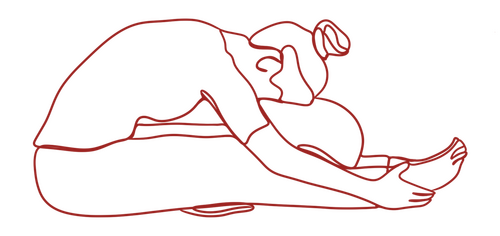
Target Areas:
- Hamstrings
- Glutes
- Thoracolumbar fascia
Benefits:
- Stretches the spinal ligaments and hamstrings
- Improves digestion by compressing & stimulating the abdominal organs
- Improves functioning of the kidneys and adrenals
Contraindications:
- For people with tight hamstrings, this pose needs to be modified to avoid strain in the back.
How to Practice:
- Sit with both legs straight out in front of you, feet together or hip width apart. Breathe in and raise your arms toward the ceiling.
- As you breathe out, reach out forward with your hands toward your ankles. Aim your nose to your knees so the back is round.
- To come out slowly roll up.
Modifications:
- If you have a tight lower back, open your feet apart, or sit on a cushion.
- If hamstrings are tight, bend the knees and place a bolster under the knees. You can support your head with your hands.
Counter Poses:
- Diamond Pose
- Crocodile Pose
- Table Pose
Recommended Hold Time for Beginners:
- 5 – 7 minutes
4. Dragonfly (Straddle)
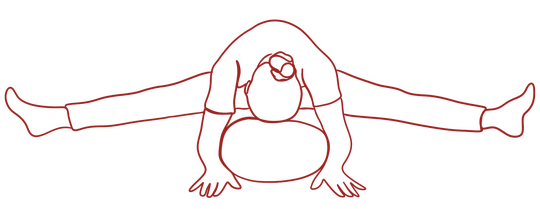
Target Areas:
- Groin
- Hamstrings
Benefits:
- Opens the hips, groin and stretches the hamstrings
- Stretches the adductor muscles
Contraindications:
- People with sciatica or lower back issues will find this pose uncomfortable.
- People with tight hamstrings will need to modify it.
How to Practice:
- Come in a sitting position.
- Open your legs wide, keeping the knees and feet pointing upwards.
- Walk forward with your hands as far as possible.
- To come out of the pose, simply walk back with your hands and bring the legs together.
Alignment Cues:
- Feet are slightly active
- Try to keep the back as straight as possible
Modifications:
- In case of sciatica issues, you can place a blanket under your hips.
- In case of lower back issues, keep the back as straight as possible.
- In case of tight hamstrings, you can place bolsters or cushions under your knees.
- If you are flexible you can place your forehead on the ground and stretch the hands to the sides.
- You can use a bolster under the chest if you can’t fold all the way down.
- If the head is too heavy for the neck, support the head in hands.
Also Read: Gentle Bedtime Yoga
Counter Poses:
- Corpse pose
- Crocodile Pose
- Sphinx
Recommended Hold Time for Beginners:
- 5 – 7 minutes
5. Twist
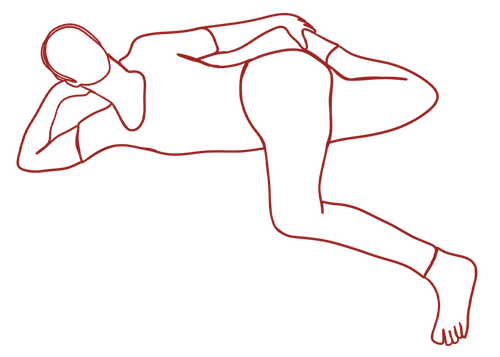
Target Areas:
- Glutes
- Groin
- Hip flexors
- Obliques
- Thoracolumbar fascia
Benefits:
- Compresses the lateral lower back
- Stretches the glutes, quadriceps, and upper thighs
Contraindications:
People with lower back pain should enter this pose gently. They may not be able to bend the knee and pull the foot too far back.
How to Practice:
- Lie down on your right side.
- Extend your left leg in front of you and bend your right leg behind you.
- Hold your right foot with your left hand while resting on the right elbow. Gently push the right knee away from you.
- To come out, release the bottom foot and roll onto your stomach. Straighten the bottom leg and roll onto your back.
Modifications:
You can lie down on the ground and raise your supporting hand above the head.
Counter Poses:
- Child’s Pose
- Corpse Pose
- Air Release Pose
Recommended Hold Time for Beginners:
- 3 – 5 minutes each side
Best Sequences in Yin Yoga
The purpose of a Yin Yoga sequence is to stretch and stress certain yin tissues in the body. Holding these passive poses for several minutes also allows the entire nervous system to calm down and the mind to fully relax. That said, it’s important to remember that an overly intensive Yin Yoga sequence can result in too much stress on a particular joint or region and have the opposite effect.
Whether you are a teacher or a practitioner wanting to try this practice at home, these 4 Yin Yoga sequences can be practiced daily to deeply stretch the connective tissues and improve range of motion. Each of these sequences have been purposely designed to target:
- Legs and spine
- Stress release
- Groin and lower spine
- Whole body
Use of Props in Yin Yoga
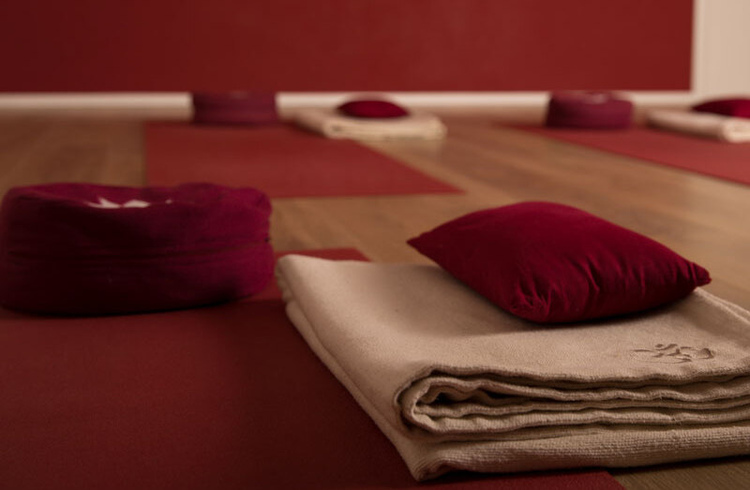
In Yin Yoga, it is common to use props to hold the pose in the proper manner. Yoga props can be used to increase or decrease the stress and to take some of the body weight, so we can become more comfortable in the pose. Sometimes props are also necessary to put more stress on a target area. Common Yin Yoga props include:
- Cushions
- Blocks
- Bolsters
- Belts / Straps
- Blankets
Tips for Using Props
When practicing Yin Yoga, follow the principle of:
- red zone (very uncomfortable, even painful),
- orange zone (uncomfortable but fine), and
- green zone (feel nothing) zone.
The goal is to find and stay in the orange zone.
- Use props only when required, or you can become dependent on them. The general rule is that if you need more than 2 cushions, you need to do a variation of this pose.
- Use wall variations when required.
See: How to Use Yoga Blocks: Poses, Benefits & Pro Tips
Frequently Asked Questions About Yin Yoga
What’s the Difference Between Yin Yoga & Hatha Yoga?
Yin Yoga poses are very similar to Hatha Yoga poses. In Yin, we target the denser and deeper tissues like ligaments, joint capsules, cartilage, bones, and fascia. Generally, Yin Yoga poses target the area from the belly to the knees, so the poses are focused on the lower body. But as yin tissues are also found in the upper body, we can apply the principles of Yin Yoga to all parts of the body. Here are the key differences between Yin and Hatha Yoga:
Differences Between Yin & Hatha Yoga
Yin Yoga | Hatha Yoga |
|---|---|
Modern yoga style from 1980 | Ancient style, more than 6000 years old |
Focuses on the connective tissues and improving the range of motion | Focuses on internal organs, endocrine glands, and the energy body |
Passive yoga style with only resting poses | Varied yoga style that comprises active and passive yoga poses |
Only teaches yoga poses | Combines poses, breathing exercises, locks, mantras, and cleansing kriyas |
Aims to only stretch and lengthen the body | Aims to stretch, strengthen, stimulate, and cleanse the body |
However, there are a few similarities between Yin and Hatha Yoga as well:
- Hatha Yoga is the foundation of all yoga poses, so all the poses in Yin Yoga are from Hatha Yoga, just with different names.
- In both yoga styles, the poses are held for a longer duration of 1-5 minutes.
- Both use the principle of minimal action.
- Yin and Hatha Yoga are suitable for people recovering from injuries.
How is Yin Yoga different from other yoga styles?
- Most yoga styles are practiced for strength, balance, and flexibility. Yin Yoga is done only for stretching, myofascial release, and increasing range of motion.
- The body temperature increases in other yoga styles, but in Yin Yoga, it remains steady and constant.
- In other styles, the oxygen consumption increases, while it decreases in Yin as there is no stress on muscles or need for extra energy.
- In other styles, the body may create lactic acid, but in Yin Yoga, this never happens.
- The chance of injury in other dynamic styles is much higher.
Is Yin & Restorative Yoga the Same?
Yin Yoga is not Restorative Yoga. It is mindfully stretching the connective body tissues. In Yin, you are in a natural active state, while in Restorative Yoga, you are in a rest state.
Read more: The difference between Yin Yoga and Restorative Yoga
How Often Should You Practice Yin Yoga?
You can practice Yin Yoga every day as there is no muscular exhaustion, so no rest period is required. Personally, I recommend practicing three days a week, 90 minutes each time. Practicing early in the morning is not always ideal because the body is cold, and the joints are stiff. I suggest practicing in the afternoon or evening when the body is warm, and the joints have been moved in a natural way.
Can You Do Yin Yoga While Pregnant?
In general, pregnant women in their third trimester should avoid practicing Yin Yoga. In this period, the body releases hormones to increase the flexibility in the joints, so there is a higher chance of over-stretching and causing injury. Women recovering from birth should also avoid it.
See: Yoga During Pregnancy: Benefits & Poses to Soothe Common Aches & Pains
Who Are the Top Teachers of Yin Yoga in the World?
Some of the best known Yin Yoga teachers are:
- Paul Grilley
- Sarah Powers
- Paulie Zink
- Bernie Clark
- Biff Mithoefer
- Ram Jain
Which Are the Best Books on Yin Yoga?
There are many books available on Yin Yoga. Some of the best are:
- Yin Yoga – Principles & Practice by Paul Grilley, ISBN-10 : 1935952706
- The Complete Guide to Yin Yoga by Bernie Clark, ISBN-10: 0968766587
- The Yin Yoga Kit by Biff Mithoefer, ISBN-10 : 1594771162
Final Thought
In a society that glorifies a fast-paced life, Yin Yoga rises as a unique practice designed to promote stillness, introspection, and deep-seated healing. While yoga, in all its forms, is transformative, Yin Yoga stands out for its focus on accessing deeper layers of the body and cultivating profound self-awareness. For those interested in learning more about this modern style, I encourage you to practice our sequences daily, or better yet, join Arhanta’s Yin Yoga Teacher Training and embark on a gentle yet powerful journey towards holistic wellness.

Get the illustrated e-book 10 Yin Yoga Poses for the Upper Body by Ram Jain for free

